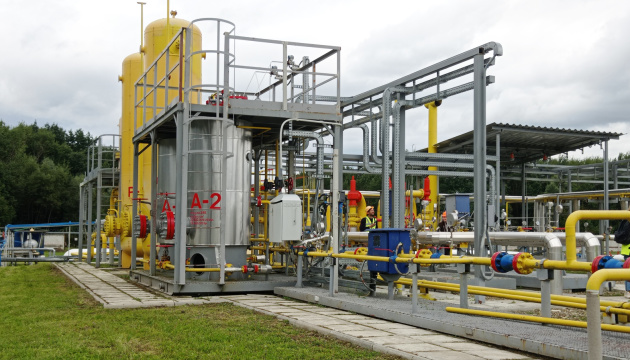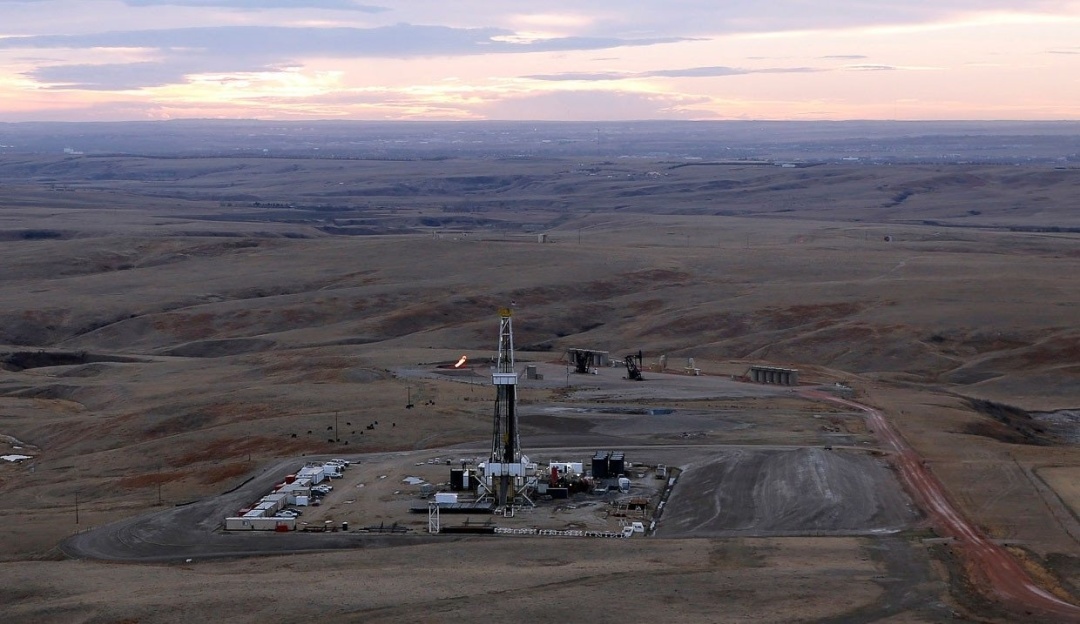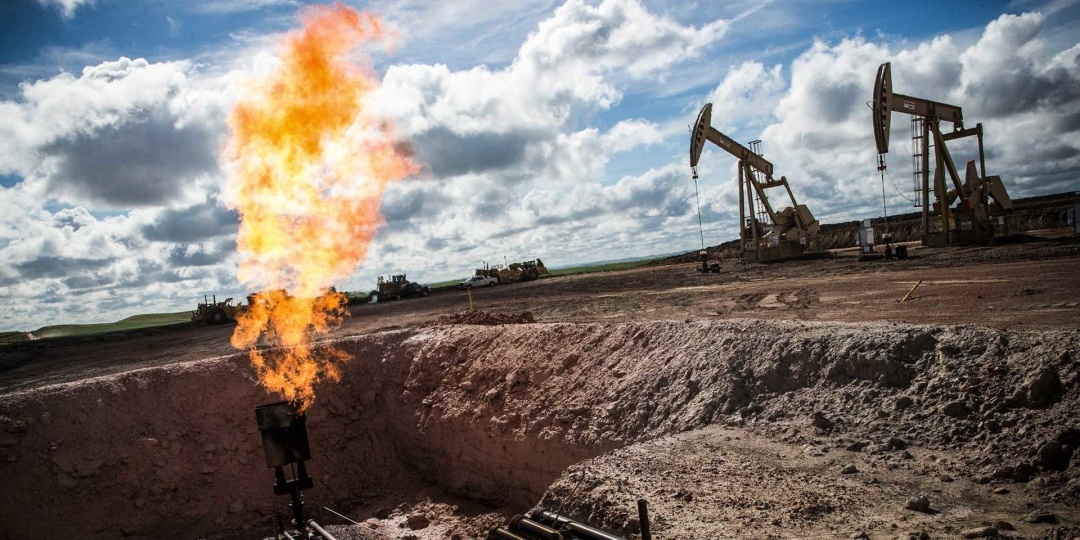
Yuzivka: Between fake news and truth about Ukraine's gas independence
Russia is trying to prevent Ukraine from extracting own gas, being interested in the opposite
When it comes to gas production in Donbas, Russia, usually completely indifferent to environmental issues, suddenly poses as deeply eco-aware, warning of all kinds of alleged man-made disasters. The sole goal of these horror stories is to keep Ukraine dependent on Russian energy.
In Ukraine, the largest gas fields are already depleted by 80-85%. At the same time, it still has significant but still undiscovered gas reserves in hard-to-reach areas or solid rock. In particular, the exploitation of the Yuzivska gas field in the Donetsk and Kharkiv regions could provide massive investment, create new jobs, and replenish local budgets with incoming taxes. However, Russia is trying to prevent this from happening as it is interested in Ukraine being weak and dependent.

It has “helpers” in Ukraine, too. On December 13, the OPFL party issued on its official website a statement claiming that “the Donbas is threatened with an environmental catastrophe due to river pollution in connection with shale gas production.”
In addition to the fact that shale gas is not yet being produced in Donbas, according to expert data, the release of toxins occurred in Kharkiv region, north of Izium. Therefore, it is not related to gas extraction from rocks.
However, this doesn’t stop pro-Russian politicians from sowing panic by speaking out against own production of gas that Ukraine needs so much.
“Condemning the Slavs to slow extinction”
How did the war in Donbas begin? In objective reality, it began with the attack on April 12, 2014, by a group of militants led by former FSB colonel Igor Girkin (Strelkov). Of course, this could not be a private initiative: the armed conflict on the border with Russia involving Russian citizens could not have started without the Kremlin's command.
But Moscow propaganda kept making up outrageous stories around it – on the one hand, to cover their direct guilt for unleashing the war, and on the other, to turn the local population against Ukraine.
One of these stories is worth mentioning. Back when the team of the then-president Viktor Yanukovych was looking for alternative ways to get gas, to which end they y signed contacts with Shell for shale gas production in Donbas, pro-Russian forces in Ukraine launched a protest campaign, which in 2013 was held under the slogan “Shale gas will kill Donbas.”

The campaign could compete with the latest boogeyman stories related to vaccination for COVID-19 in the most absurd news contest.
For example, one of the manifestos claimed that the true purpose of these treaties is to “poison the ground, surface waters, the Siversky Donets River, and the Sea of Azov” to “condemn to slow extinction several million Slavs, residents of Donetsk, Kharkiv, Luhansk regions, and Lower Don as potential opponents of the future confrontation of the China–Russia empires with America.”
With the onset of Russian aggression in Donbas, this fake narrative was revisited and circulated in different variations.
“In 2013, in Davos, Yanukovych signed an agreement with Shell on ‘the Yuzivskyi project,’ that is, on shale gas production in Donetsk and Luhansk regions. Due to shale gas production, Ukraine could cover 50% of own gas demand… Mass protests of residents of the Southeast against Shell began a year ago so the work was suspended. However, after the CIA director came to talk to the Kyiv authorities, the Ukrainian leadership launched a military operation against the Southeast of Ukraine. The war against the DPR, especially the brutal shelling and bombing of settlements, is only a way to destroy and displace 100,000 residents of Donbas who are protesting against the poisoning of groundwater, soil, and air of their native land.” (A. Shoykhet, a Russian-speaking Israeli publicist. July 2014)
“Viktor Yanukovych, while he was president of Ukraine, sold the land of Donetsk and Luhansk regions to world giants, Chevron and Shell, for the sake of shale gas production. As a result, it is important to simply purge the territory of the population so that people don’t get in the way and that no one receives compensation. People cannot live in the areas where shale gas is extracted, which means that entire cities would have to be resettled in Donbas. War is cheaper.” (Giulietto Chiesa, now a deceased Italian communist, closely associated with the USSR, and then with Russia. September 2014)
According to this logic, if we stick to the facts, Yanukovych, who signed the agreement, was an American asset. Also, an American asset was Girkin (Strelkov), who created a casus belli, a pretext for war. And the Kremlin, it turns out, is also full of American assets because without a direct invasion of Russian troops, the war in Donbas would have ended before it even began.
“A surprise twist”
At the same time, Russia Gazprom stuck to an entirely different line, rejecting the idea that the war in Donbas is in any way connected with gas. In Ukraine, they say, there is no shale gas at all, and if there is, its production would be unfeasible.
That is, what the Gazprom corporate magazine wrote in July 2014: “Recently, there has been an unexpected turn in the topic of shale gas. First, there are numerous reports that the war in Ukraine is going on because of shale gas deposits… If we talk about shale gas in Ukraine, it is not yet clear at all whether it is there or not; they are only looking for it, but to no avail. There is a high probability that profitable shale gas reserves on the territory of Ukraine will not be identified.”
This should be seen as the fact that Gazprom would not want Ukraine to gain additional energy sources. There was some truth in that report though: there is no shale gas production in Ukraine, its reserves have not been confirmed, while their exploration and extraction are economically unfeasible.
Now we will explain exactly what kind of gas it is planned to produce in Donbas.
Some Russian propaganda pundits have combined the two narratives: in fact, there are no gas deposits/its production is unprofitable, therefore, the arrival of foreign gas producers in Donbas is actually a cover operation for something even more menacing.
Logic wasn’t so necessary; the main thing was to establish the following cause and effect relationship in the minds of propaganda consumers: gas production in Donbas would lead to a disaster.
Inventing a lie is easier than refuting it. Brandolini's law (also known as the “the bullshit asymmetry principle”) states: “The amount of energy needed to refute bullshit is an order of magnitude larger than to produce it.”
Shell and Chevron left Ukraine, including due to the resistance of local residents, turned against gas production by Russian propaganda, and the proximity of the potential fields to the front line. The project was mothballed.
This is about the Yuzivska gas field: this is the largest (7,886 km2) oil and gas area in the Dnipro-Donetsk Basin, stretching across Donetsk and Kharkiv regions. Now it is the most promising one in Ukraine’s lands.
Studies show that the field is capable of delivering up to 10 bcm of natural gas annually: almost a third of Ukraine’s overall consumption.
For seven years, this rich subsoil wasn’t used in any way. So, Ukraine was losing potential gas, taxes, jobs, and social investment.
Last year, the Yuzivska gas field was handed to the state-owned Naftogaz of Ukraine for exploration and production. Since December 2020, it has been the owner of the Nadra Yuzivska company, which has rights to the Yuzivska gas field.
Naftogaz has already collected the required geological data and started the first fieldwork – the restoration of old, previously mothballed wells. Subsequently, the company plans to drill new ones.
But the Ukrainian company has faced the same resistance as foreign actors once had. Russian propagandists are once again undermining the idea of hydrocarbon production in Donbas. And to this end, they resurrected the seemingly forgotten myth, in which the American line emerged again for some reason.
"Shale gas mined in Donbas is much cheaper than that produced in the United States. And with its help, Biden and others expect to oust Russia from the gas market ... Americans need the territory of Donbas but they do not need its people. They need the local population to leave these lands.” (Serhii Zavorotnii, councillor to Ukraine’s former Prime Minister Mykola Azarov, in an interview with Moskovskiy Komsomolets, April 2021)
Apparently, they hope no one will remember what happened in the previous “episodes” when they claimed that even if there is some gas in Donbas, it makes no economic sense to extract it. Then nonsensical headlines such as "shale ecocide" and "shale genocide" came into play.
"Unconventional", but just as natural
First of all, this myth is about some opaque, alien method of gas extraction, which is so dangerous that it has been abandoned all over the world.
All this is a total lie.
In the case of Yuzivska Square, it is not about the production of shale gas, but that of the so-called gas from rock (central basin type). It is stored in geological formations very similar to those that are home to ordinary natural gas, albeit with a slower flow rate.
It is not gas as such that’s “unconventional,” but the method of its extraction. The difference is that gas comes from reservoirs with low permeability and low porosity.
Extraction of gas from those reservoirs requires hydrofracturing: subsurface cracks are opened and expanded by introducing water, chemicals, and sand under high pressure.
Again, despite its “unconventionality," the method has been around for over 70 years.
- The first commercial hydrofracturing operation was launched by Halliburton in 1949. Since then, more than a million boreholes have been drilled in the United States.
- In the former USSR, the first industrial fracturing experiment took place in 1952.
- The world's first coal fracturing took place in Ukraine in the Donetsk basin in 1954 as part of works on underground coal gasification.
- In the same year, 1954, in Boryslav, for the first time in Ukraine, a new technology of intensifying oil inflow by means of fracturing was introduced.
- You can read about the history of hydraulic fracturing in Donbas in an article by Mykola Filimonenko where he describes the industrial tests of directed hydraulic dismemberment of coal beds in the 1970s. They were carried out as part of the task to find own energy sources and prevent shortage.
- In 2018, production of compacted gas, shale gas, and coal bed methane combined, which all require hydrofracturing, accounted for 41% of total domestic natural gas production in China. It is used to mine gas from low-permeability strata since the 1970s.
- In 2016, horizontal boreholes for fracturing accounted for 69% of all oil and natural gas wells drilled in the United States and 83% of the total number of linear wells.
-
- According to Baker Hughes data from 2019, almost 90% of all new oil and gas wells are horizontal fractured wells.
- Dependence on foreign oil has risen sharply in California, where no fracturing has been developed.
- Prior to the fracturing boom, the United States as a whole became increasingly dependent on foreign oil. In 2016, the United States was self-sufficient — 86% to 91%.
- Russia and Belarus produce more than 2,000 hydraulic fracturing units annually. Belarusnafta has created a team that has already made more than two hundred fractures. An American plant for the production of fracturing equipment is located in Belarus.
Who set tap water on fire?
One of the most famous episodes of the 2010 Gasland by American director John Fox, which contributed to the rise of an anti-fracking movement (and was widely used as a reference in Ukraine as well) turned out to be a sham. In this episode, a man sets the water flowing from a tap on fire.
According to the Colorado Department of Natural Resources, the investigation showed that the gas in the man's water supply system "is not related to oil and gas activities." The report goes on to say that it has been well known for decades that the aquifer in the area is contaminated with natural methane.
Methane entering the artesian well was created during bacterial fermentation of organic matter at shallow depths and was not thermogenic (natural gas produced from shale formation).
When confronted about it, the director he admitted he had been aware that the episode with burning water was unrelated to gas extraction by fracturing (also referred to as "fracking"). But the damage was already done as a vivid propaganda picture went viral.
Gazprom really loved the film, by the way. Also, the director was publicly accused of taking money from a Russian company to shoot it.
This story should be a lesson teaching us to verify facts and listen to experts.
The experts, for their part, say that, for instance, reagents for drill mud, which, some propagandists believe, “kill everything alive,” are purchased not on the black market of biological weapons, but instead from regular and official suppliers of chemicals, and they are “barely different from shampoo and liquid soap.”
They also explain that there is a structure which is much more dangerous for the environment than a borehole — the sewer of a small village.
A borehole is a pipe with a capacity of 200 tonnes. The largest fracture in Ukraine was 1,200 tonnes. For scale, experts suggest looking at one of Ukrainian smaller towns after rainfall in May – they say that “rain alone creates a [similar] hydraulic fracture three times a month. The storm sewer, 500 mm in diameter around the central square and 200 meters long, is overflowing. In the ravine formed, stormwater flows in a volume of 4 tons per minute. This water is a solution of salts and oils, exhaust gases that have accumulated over the winter in dust and dirt on the asphalt surface.
“And what about unloading pits and fertilizers which are often used in the fields and vegetable gardens? And this does not happen at a depth of 4,000 meters,” say the experts.
Wells will not become shallow, water will not go, soil will not sink, air will not be polluted, radiation levels will not increase.
However, Ukraine will take a big step towards energy independence. And local communities will benefit from infrastructure and social projects.
For example, a company paid UAH 1.7 billion in rent to the local budget of Oskilska amalgamated community for the Sviatohirsk field in 2018-2020. And in some amalgamated communities of Poltava and Kharkiv regions, annual rent paid by Naftogaz reaches over UAH 40 million.
So, there is something to fight for. Yuzivka is truly one of the sources of Ukraine's gas independence. We should just prevent it from getting clogged with fake news.
Center for Strategic Communication and Information Security
